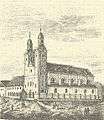Udvarhelyszék
| Udvarhelyszék | |||||
| Seat of the Székely Land | |||||
| |||||
|
Coat of arms | |||||
| Capital | Székelyudvarhely | ||||
| History | |||||
| • | Hungarian conquest of the Carpathian Basin | 10–11th century | |||
| • | Settlement of the Székelys | 12th century | |||
| • | Administrative reform of the Kingdom of Hungary | 1876 | |||
| Population | |||||
| • | 1867 | 96,929 | |||
| Today part of | Romania | ||||
| Odorheiu Secuiesc is the current name of the capital. | |||||
Udvarhelyszék (Hungarian pronunciation: [ˈudvɒrhɛjseːk]) was one of the Székely seats in the historical Székely Land.
Situated on the western part of the Székely Land, it was the main seat (Hungarian: anyaszék, Latin: sedes principalis, sedes capitalis) for a significant period, being the home of the Count of the Székelys and the Székely National Assembly; it also fulfilled the main administrative and judiciary functions.
It administered two sub-seats (Hungarian: fiúszék, Latin: sedes filialis): Bardócszék and Keresztúrszék.
Population
The religious make-up of Udvarhelyszék in 1867 was the following:
- Calvinist: 35,759
- Roman Catholic: 34,282
- Unitarian: 22,263
- Greek Catholic: 2,054
- Greek Orthodox: 1,847
- Jewish: 115
- Lutheran: 113
- Foreigner: 496
- Total: 96,929
Gallery
 People of Udvarhelyszék wearing traditional costumes
People of Udvarhelyszék wearing traditional costumes A typical Székely house in Udvarhelyszék
A typical Székely house in Udvarhelyszék The Catholic Church of Székelyudvarhely with the Catholic Gymnasium
The Catholic Church of Székelyudvarhely with the Catholic Gymnasium The Franciscan Monastery of Székelyudvarhely
The Franciscan Monastery of Székelyudvarhely Reformed (Calvinist) Church of Székelyudvarhely with the Reformed High School
Reformed (Calvinist) Church of Székelyudvarhely with the Reformed High School
References
- Orbán, Balázs (1868). A Székelyföld leírása. Pest: Panda és Frohna Könyvnyomdája.
This article is issued from Wikipedia - version of the 11/7/2016. The text is available under the Creative Commons Attribution/Share Alike but additional terms may apply for the media files.
